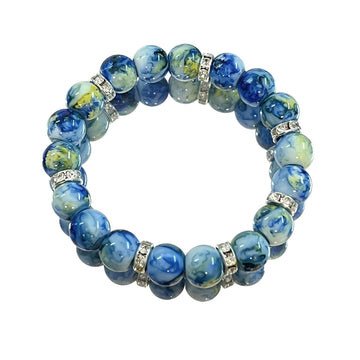Skin allergies that occur when wearing stone bracelets are usually caused by factors such as the material of the stone bracelet, surface treatment process, or bacteria that breed during wearing, which irritate the skin. The following are some coping methods:
Stop wearing immediately.
Once allergic symptoms such as itching, redness, swelling and rashes are found on the skin after wearing a stone bracelet, the bracelet should be removed immediately to avoid continuous skin irritation and prevent the allergic symptoms from worsening. Just like when the skin comes into contact with irritating chemicals, if it is not removed in time, the allergic reaction will become more and more serious.
Clean the skin
Gentle cleaning: Gently rinse the skin of the allergic area with mild water to remove dust, dirt and substances that may cause allergies from the surface of the bracelet that may remain on the skin. The water temperature should not be too high or too low; it is advisable to be close to body temperature to avoid irritating the skin.
Use mild cleaning products: If the allergic symptoms are quite obvious, you can use mild and non-irritating cleaning products, such as baby-specific body wash or facial cleanser. Gently rub the allergic area and then rinse it clean with water. However, it is important to avoid using cleaning products that contain irritating ingredients such as alcohol, fragrances, and pigments, as this may aggravate skin allergies.
Relieve allergic symptoms
Cold compress: Wrap ice cubes or a chilled mineral water bottle in a clean towel and apply cold compress to the allergic area. Cold compresses can congest blood vessels, reduce skin congestion and swelling, and relieve itching and pain. Each cold compress should last for about 10 to 15 minutes and can be done multiple times a day. This is just like applying ice packs to the injured skin to reduce the inflammatory response.
Apply ointment: If the allergic symptoms are mild, you can apply some ointments with anti-itch and anti-inflammatory effects under the guidance of a doctor, such as calamine lotion. It has astringent and skin-protecting effects and can relieve itching. Hydrocortisone cream and other weak hormone ointments can reduce the inflammatory response of the skin, but it is necessary to pay attention to the usage time and frequency, and avoid long-term and excessive use.
Oral antihistamines: If the allergic symptoms are severe, such as extensive redness, swelling, unbearable itching, or even accompanied by systemic symptoms like breathing difficulties, medical attention should be sought promptly. Under the guidance of a doctor, oral antihistamines such as loratadine and cetirizine should be taken. These drugs can prevent the occurrence of allergic reactions and relieve allergic symptoms.
Observation and Medical Treatment
Close observation: After taking the above measures, it is necessary to closely monitor the changes in allergic symptoms. If the symptoms gradually ease, it indicates that the treatment measures have been effective. You can continue to observe and take good care of your skin. However, if the symptoms do not ease and even show a worsening trend, such as the expansion of redness and swelling, the appearance of blisters, and exudation, medical attention should be sought promptly.
Professional diagnosis: After arriving at the hospital, the doctor will conduct a detailed examination and diagnosis based on the specific situation. They may perform skin allergen tests to determine the exact cause of the allergy, thereby formulating a more targeted treatment plan.
Follow-up prevention
Understand the material of the bracelet: Before purchasing a stone bracelet, it is necessary to understand its material composition. If you were allergic to a certain material before, you should avoid purchasing and using bracelets containing that material again. For instance, if some people are allergic to nickel, then it is necessary to pay attention to whether the bracelet contains nickel.
Pay attention to wearing hygiene: Regularly clean the stone bracelet to keep its surface clean and hygienic. You can gently wipe the bracelet with a soft cloth to remove dust and dirt. At the same time, pay attention to personal hygiene, keep the skin clean and dry, and avoid the interaction between bacteria and dirt on the skin and the bracelet, which may cause allergies.







